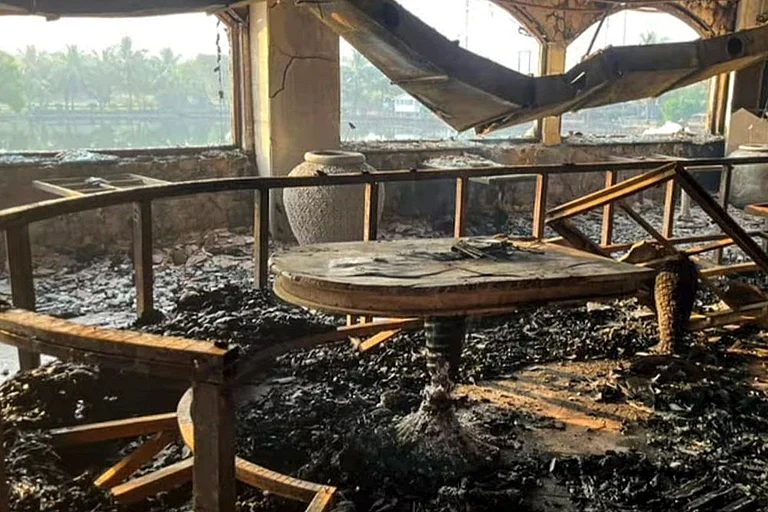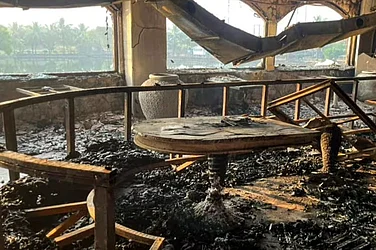June 20 was the day we noticed water seeping into our house. It was also the same day that my wife entered into her 38th week of pregnancy. We had experienced flash floods in our lane before, but it never entered our threshold. June 20 was different. It had been raining for the past few days, but flooding in the central town of Silchar was unlikely. Around 6am, we noticed water inside our house. So, we started moving the furniture to the first floor. But we were not prepared for neck-deep water on the ground floor by the evening.
This is the first time I have experienced floods in the 34 years of my life. We stay in the Ashutosh lane of Sonai Road in the central part of the town. Preparedness was nil. I had been busy taking care of my pregnant wife. We received news that flooding had occurred in some parts of Silchar, but never thought an entire river would enter the town area. When I saw the state of the lane in front of my house from the terrace, I realised this is not normal. The water had a very high current. Someone told me that a dyke (embankment to prevent flooding) on the Barak River in the Betukandi area had been breached. The current made it impossible for the people to get out of their houses and swim across the turns to reach the road.
Suddenly the electricity went off. Then the supply of drinking water stopped. That’s when I started calling flood helplines and the NDRF. Many responded. However, the neck-deep water along with heavy current, made the boats impossible to reach my doorstep. From the main road, it takes five turns to reach my house and at each turning, the current was high. Soon, the mobile network disappeared. In time, the phone battery began to die and our mobiles switched off. Simultaneously, we started to make a raft out of bamboo that we happen to keep in the house for construction purposes. But the raft didn’t work in the high currents.
On June 22, a team of NDRF reached the main road, but had to withdraw due to the high currents. They told us if we could somehow help them pull the boats with the help of ropes then they might be able to enter our lane. That night I started harvesting rainwater for drinking. It was impossible to contact emergency numbers with no phone network or battery. My sister who stays in Calcutta got in touch with the district administration to urgently rescue us citing my wife’s condition.
On June 23, my brother, my brother-in-law and a neighbour reached outside our house. There was no change in the water level. We tied ourselves with ropes to support each other as we started wading through the flood water towards the NDRF boats which were on standby, half a kilometre away on the main road. Suddenly I slipped and went under but before I got dragged by the currents, the NDRF team rescued me. We helped the team by pulling the boat towards us and guiding it to our house slowly and carefully.
On reaching the house, the NDRF team rescued my wife. She was brought into the boat with the help of a thresher. The rescue point was Narishikkha Hospital on Park Road which is in town, and one of the few roads that had not been inundated yet.
Till now, we had been in consultation with the Jeevan Jyoti Hospital in the Meherpur area for my wife’s pregnancy. But the road to that hospital was inundated. The doctors in Narishikkha Hospital asked me to get my wife admitted as they told she might get into labour at any moment. So, we stayed in the hospital from June 23.
On June 27, my wife delivered a baby girl. We are still residing at the hospital. The flood water in my lane started to recede. An officer from the NDRF team visited us amidst the crisis to get an update on my wife. My father and my brother are staying on the second floor of the house. Many of my neighbours who were living in typical Assamese constructed houses were taking shelter in the nearby buildings.
On Sunday (July 2), we went back home with our baby girl. As of now, our lane is free of flood water. However, many places in the town like Das Colony, Vivekananda Road, College Road, and many lanes in Ambikapatty, Bilpar, etc., have stagnant water. The rainfall has stopped, but the drains are clogged with filth and there is no way for the water to get out. Water is being pumped out from many places. The drainage system in Silchar is one of the worst in the state. Now there is a foul smell in many localities.
Fatakbazar, the town’s main business hub, has become the epicentre of foul smell. This is mainly due to the rotting of perishable items in godowns. Plus, the perpetual piles of garbage. Combining these two reasons have made it difficult to breathe freely. The basement of the biggest mall in Beltola point in Fatakbazar – Goldighi Municipal mall – that was a parking lot is now filled with water and garbage, and is another point of foul smell. Garbage collected from the town is mostly disposed of at a dumping yard in Maharpur. A large part of it goes into the main drainage canal in Rangirkhari, which has blocked the entire water flow leading to the disaster now the town is dealing with.
Meanwhile, the power department is checking on electricity poles damaged by the flood, and attempting to restore power. This flood in Silchar has revealed many loopholes in the town’s infrastructure. The most significant ones are poor town planning and maintenance. There was a warning from the administration on June 19 that the Betukandi dyke was damaged, but till June 20-21 there was no preparedness. It was sad to witness local public representatives distributing relief materials like drinking water bottles only before the Assam Chief Minister’s visit. The havoc of floods still continues in many places. The heavy rain on Friday night again inundated many of the places where the water level was receding. The Barak River is rising slowly again.
My own college has become the largest relief camp in Silchar, sheltering 2,500 people at present. A few days back, Assam Chief Minister Himanta Biswa Sarma visited the camp to take stock of the situation. The last time, my college was turned into a relief camp was in 2007. I was in the second year of BSc (Bachelor of Science). Perhaps, this is the most devastating flood of the century in Silchar.





















